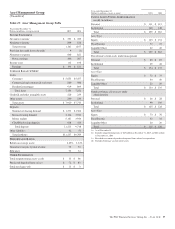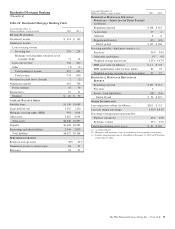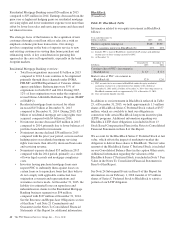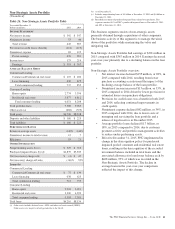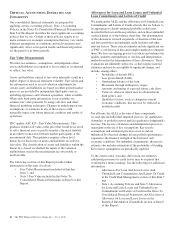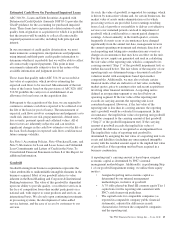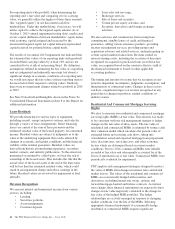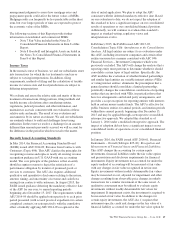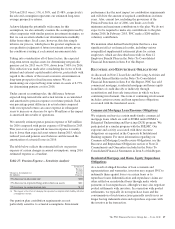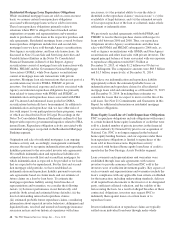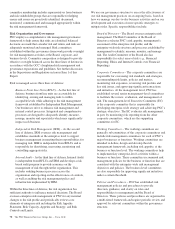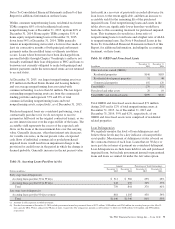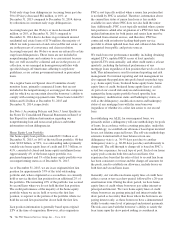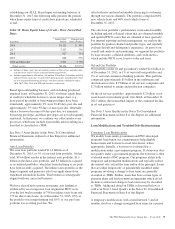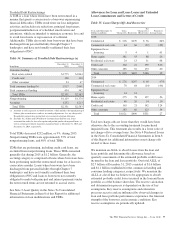PNC Bank 2015 Annual Report Download - page 85
Download and view the complete annual report
Please find page 85 of the 2015 PNC Bank annual report below. You can navigate through the pages in the report by either clicking on the pages listed below, or by using the keyword search tool below to find specific information within the annual report.
2014 and 2013 were (.1%), 6.50%, and 15.48%, respectively),
the selected assumption represents our estimated long-term
average prospective returns.
Acknowledging the potentially wide range for this
assumption, we also annually examine the assumption used by
other companies with similar pension investment strategies, so
that we can ascertain whether our determinations markedly
differ from others. In all cases, however, this data simply
informs our process, which places the greatest emphasis on
our qualitative judgment of future investment returns, given
the conditions existing at each annual measurement date.
Taking into consideration all of these factors, the expected
long-term return on plan assets for determining net periodic
pension cost for 2015 was 6.75%, down from 7.00% for 2014.
This reduction was made after considering the views of both
internal and external capital market advisors, particularly with
regard to the effects of the recent economic environment on
long-term prospective fixed income returns. We are
maintaining our expected long-term return on assets at 6.75%
for determining pension cost for 2016.
Under current accounting rules, the difference between
expected long-term returns and actual returns is accumulated
and amortized to pension expense over future periods. Each
one percentage point difference in actual return compared
with our expected return can cause expense in subsequent
years to increase or decrease by up to $8 million as the impact
is amortized into results of operations.
We currently estimate pretax pension expense of $43 million
for 2016 compared with pretax expense of $9 million in 2015.
This year-over-year expected increase in expense is mainly
due to lower than expected asset returns during 2015, which
reduced year-end pension asset balances and increased the
amortization of actuarial losses in 2016.
The table below reflects the estimated effects on pension
expense of certain changes in annual assumptions, using 2016
estimated expense as a baseline.
Table 27: Pension Expense – Sensitivity Analysis
Change in Assumption (a)
(In millions)
Estimated
Increase
to 2016
Pension
Expense
.5% decrease in discount rate $18
.5% decrease in expected long-term return on assets $21
.5% increase in compensation rate $ 2
(a) The impact is the effect of changing the specified assumption while holding all other
assumptions constant.
Our pension plan contribution requirements are not
particularly sensitive to actuarial assumptions. Investment
performance has the most impact on contribution requirements
and will drive the amount of required contributions in future
years. Also, current law, including the provisions of the
Pension Protection Act of 2006, sets limits as to both
minimum and maximum contributions to the plan. We do not
expect to be required to make any contributions to the plan
during 2016. In February 2015, PNC made a $200 million
voluntary contribution.
We maintain other defined benefit plans that have a less
significant effect on financial results, including various
nonqualified supplemental retirement plans for certain
employees, which are described more fully in Note 12
Employee Benefit Plans in the Notes To Consolidated
Financial Statements in Item 8 of this Report.
R
ECOURSE AND
R
EPURCHASE
O
BLIGATIONS
As discussed in Note 2 Loan Sale and Servicing Activities and
Variable Interest Entities in the Notes To Consolidated
Financial Statements in Item 8 of this Report, PNC has sold
commercial mortgage, residential mortgage and home equity
loans/lines of credit directly or indirectly through
securitization and loan sale transactions in which we have
continuing involvement. One form of continuing involvement
includes certain recourse and loan repurchase obligations
associated with the transferred assets.
Commercial Mortgage Loan Recourse Obligations
We originate and service certain multi-family commercial
mortgage loans which are sold to FNMA under FNMA’s
Delegated Underwriting and Servicing (DUS) program. We
participated in a similar program with the FHLMC. Our
exposure and activity associated with these recourse
obligations are reported in the Corporate & Institutional
Banking segment. For more information regarding our
Commercial Mortgage Loan Recourse Obligations, see the
Recourse and Repurchase Obligations section of Note 21
Commitments and Guarantees included in the Notes To
Consolidated Financial Statements in Item 8 of this Report.
Residential Mortgage and Home Equity Repurchase
Obligations
As a result of alleged breaches of loan covenants and
representations and warranties, investors may request PNC to
indemnify them against losses on certain loans or to
repurchase loans. Indemnification and repurchase claims are
often settled on an individual basis through make whole
payments or loan repurchases, although we may also negotiate
pooled settlements with investors. In connection with pooled
settlements, we typically do not repurchase loans and the
consummation of such transactions generally results in us no
longer having indemnification and repurchase exposure with
the investor in the transaction.
The PNC Financial Services Group, Inc. – Form 10-K 67


